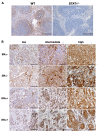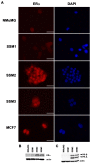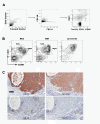STAT1-deficient mice spontaneously develop estrogen receptor α-positive luminal mammary carcinomas
- PMID: 22264274
- PMCID: PMC3496133
- DOI: 10.1186/bcr3100
STAT1-deficient mice spontaneously develop estrogen receptor α-positive luminal mammary carcinomas
Abstract
Introduction: Although breast cancers expressing estrogen receptor-α (ERα) and progesterone receptors (PR) are the most common form of mammary malignancy in humans, it has been difficult to develop a suitable mouse model showing similar steroid hormone responsiveness. STAT transcription factors play critical roles in mammary gland tumorigenesis, but the precise role of STAT1 remains unclear. Herein, we show that a subset of human breast cancers display reduced STAT1 expression and that mice lacking STAT1 surprisingly develop ERα+/PR+ mammary tumors.
Methods: We used a combination of approaches, including histological examination, gene targeted mice, gene expression analysis, tumor transplantaion, and immunophenotyping, to pursue this study.
Results: Forty-five percent (37/83) of human ERα+ and 22% (17/78) of ERα- breast cancers display undetectable or low levels of STAT1 expression in neoplastic cells. In contrast, STAT1 expression is elevated in epithelial cells of normal breast tissues adjacent to the malignant lesions, suggesting that STAT1 is selectively downregulated in the tumor cells during tumor progression. Interestingly, the expression levels of STAT1 in the tumor-infiltrating stromal cells remain elevated, indicating that single-cell resolution analysis of STAT1 level in primary breast cancer biopsies is necessary for accurate assessment. Female mice lacking functional STAT1 spontaneously develop mammary adenocarcinomas that comprise > 90% ERα+/PR+ tumor cells, and depend on estrogen for tumor engraftment and progression. Phenotypic marker analyses demonstrate that STAT1-/- mammary tumors arise from luminal epithelial cells, but not myoepithelial cells. In addition, the molecular signature of the STAT1-/- mammary tumors overlaps closely to that of human luminal breast cancers. Finally, introduction of wildtype STAT1, but not a STAT1 mutant lacking the critical Tyr701 residue, into STAT1-/- mammary tumor cells results in apoptosis, demonstrating that the tumor suppressor function of STAT1 is cell-autonomous and requires its transcriptional activity.
Conclusions: Our findings demonstrate that STAT1 suppresses mammary tumor formation and its expression is frequently lost during breast cancer progression. Spontaneous mammary tumors that develop in STAT1-/- mice closely recapitulate the progression, ovarian hormone responsiveness, and molecular characteristics of human luminal breast cancer, the most common subtype of human breast neoplasms, and thus represent a valuable platform for testing novel treatments and detection modalities.
Figures









Similar articles
-
Prolactin-induced mouse mammary carcinomas model estrogen resistant luminal breast cancer.Breast Cancer Res. 2011 Jan 28;13(1):R11. doi: 10.1186/bcr2819. Breast Cancer Res. 2011. PMID: 21276249 Free PMC article.
-
Dysregulated STAT1-SOCS1 control of JAK2 promotes mammary luminal progenitor cell survival and drives ERα(+) tumorigenesis.Cell Death Differ. 2014 Feb;21(2):234-46. doi: 10.1038/cdd.2013.116. Epub 2013 Sep 13. Cell Death Differ. 2014. PMID: 24037089 Free PMC article.
-
Truncating Prolactin Receptor Mutations Promote Tumor Growth in Murine Estrogen Receptor-Alpha Mammary Carcinomas.Cell Rep. 2016 Sep 27;17(1):249-260. doi: 10.1016/j.celrep.2016.08.076. Cell Rep. 2016. PMID: 27681435 Free PMC article.
-
Hormone-sensing mammary epithelial progenitors: emerging identity and hormonal regulation.J Mammary Gland Biol Neoplasia. 2015 Jun;20(1-2):75-91. doi: 10.1007/s10911-015-9344-1. Epub 2015 Sep 21. J Mammary Gland Biol Neoplasia. 2015. PMID: 26390871 Review.
-
Estrogen receptor-α signaling in post-natal mammary development and breast cancers.Cell Mol Life Sci. 2021 Aug;78(15):5681-5705. doi: 10.1007/s00018-021-03860-4. Epub 2021 Jun 22. Cell Mol Life Sci. 2021. PMID: 34156490 Free PMC article. Review.
Cited by
-
Single-cell transcriptomic analyses of tumor microenvironment and molecular reprograming landscape of metastatic laryngeal squamous cell carcinoma.Commun Biol. 2024 Jan 8;7(1):63. doi: 10.1038/s42003-024-05765-x. Commun Biol. 2024. PMID: 38191598 Free PMC article.
-
PTPN2 elicits cell autonomous and non-cell autonomous effects on antitumor immunity in triple-negative breast cancer.Sci Adv. 2022 Feb 25;8(8):eabk3338. doi: 10.1126/sciadv.abk3338. Epub 2022 Feb 23. Sci Adv. 2022. PMID: 35196085 Free PMC article.
-
Chronic expression of wild-type Ret receptor in the mammary gland induces luminal tumors that are sensitive to Ret inhibition.Oncogene. 2018 Jul;37(29):4046-4054. doi: 10.1038/s41388-018-0235-y. Epub 2018 Apr 26. Oncogene. 2018. PMID: 29695833
-
Cancer cell-autonomous contribution of type I interferon signaling to the efficacy of chemotherapy.Nat Med. 2014 Nov;20(11):1301-9. doi: 10.1038/nm.3708. Epub 2014 Oct 26. Nat Med. 2014. PMID: 25344738 Clinical Trial.
-
Clonal variation in interferon response determines the outcome of oncolytic virotherapy in mouse CT26 colon carcinoma model.Gene Ther. 2015 Jan;22(1):65-75. doi: 10.1038/gt.2014.83. Epub 2014 Sep 18. Gene Ther. 2015. PMID: 25231172
References
-
- Perou CM, Sorlie T, Eisen MB, van de Rijn M, Jeffrey SS, Rees CA, Pollack JR, Ross DT, Johnsen H, Akslen LA, Fluge O, Pergamenschikov A, Williams C, Zhu SX, Lonning PE, Borresen-Dale AL, Brown PO, Botstein D. Molecular portraits of human breast tumours. Nature. 2000;406:747–752. doi: 10.1038/35021093. - DOI - PubMed
Publication types
MeSH terms
Substances
Grants and funding
LinkOut - more resources
Full Text Sources
Molecular Biology Databases
Research Materials
Miscellaneous

